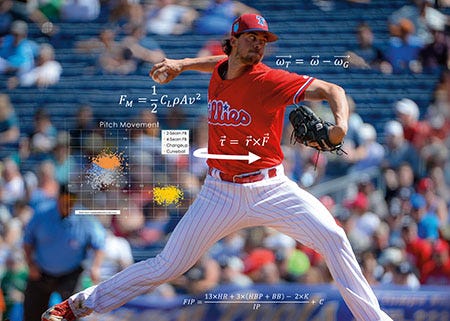Game Changer: A Penn Engineer Joins The Philadelphia Phillies

When Alex Nakahara (MEAM’10) was asked recently if he is ever able to mention his job title without someone excitedly responding with “Moneyball!” he smiled broadly and answered, “Pretty much no.”
Nakahara was quick to add, however, that he often uses the analogy to better explain what he does for a living. Nakahara is a senior quantitative analyst for the Philadelphia Phillies, and the reference is, of course, to Michael Lewis’ 2003 book, Moneyball: The Art of Winning an Unfair Game, and its 2011 award-winning film adaptation starring Brad Pitt and Jonah Hill. Recounting the story of Billy Beane, the real-life former general manager of the Oakland Athletics, the book and the film introduced to popular culture the data science specialty of baseball analytics, or sabermetrics.
Nakahara is, in fact, a sabermetrician, the term being derived from SABR, the acronym for the Society of American Baseball Research. As an article posted last year on the Phillies’ website amicably put it, he is one of “a bunch of smart people without baseball backgrounds” being hired by the team.
An Innate Curiosity
More precisely, Nakahara is one of nine analysts and software engineers whose research is centered on player performance in batting, pitching, fielding and the tactics of in-game activity. His group’s work is changing the way decisions are made in the Phillies’ front office. Their predictive findings can ultimately influence hires, trades and the scouting and training of players.

And while it is true that the word “baseball” appeared nowhere on Nakahara’s resume, his undergraduate degree from Penn in Mechanical Engineering and Applied Mechanics, master’s in Aeronautics and Astronautics from MIT, and five years as a systems engineer at Northrop Grumman made Nakahara a perfect Phillies fit. He brings to the table the mindset of an engineer: critical thinking, the ability to find problems and then solve them, and an innate curiosity about how things and systems work.
Phillies leadership considers having some analysts lacking baseball experience to be an advantage: They are able to interpret with unbiased eyes what Nakahara describes as “oceans” of game and player performance data available to all teams in equal measure. By way of digital photographic and radar technology now embedded in every Major League Baseball field, analysts can access runners’ base-to-base speed, pitch velocity and the landing location of every ball batted. Additionally, individual teams can make use of other sources, including scouting notes and players’ medical histories.
Nakahara is fairly new to the Phillies, and he admits to now and again looking around his office at Citizens Bank Park to make sure his dream job, coveted by so many newly graduated data scientists, statisticians and mathematicians, is indeed real. Visually, he can actually take in the entire office; the work area is configured on the open model so popular with tech companies these days. This design seems to work well for Nakahara’s boss, Andy Galdi, a former YouTube quantitative analyst at Google. The cubicle-free space, featuring clusters of desks and multi-user computer monitors, has proven to promote collaboration and inspire shared creative energy.
A Common Goal
Along with its players, coaches and scouts, the Phillies team includes specialists of other stripes:
physical therapists, nutritionists, conditioning experts and mental skills trainers. A video department can supply in-play clips and images that can be used by analysts to complement their numbers. With a common goal to gain a competitive advantage for the Phillies, all are welcome to bring their ideas and questions to the analytics “think tank.” Likewise, the analytics team often goes out to the other groups to learn more about their areas.
Nakahara’s collaborative professionalism aligns well with what he describes as the Phillies’ familylike work environment and inclusive team culture. He is delighted with the high-spirited perks of the job, like having the team mascot, the Philly Phanatic, appear at his wedding and being invited to get on board the Philadelphia Eagles’ Road to Victory bus for a front office photo op. His group had a presence at spring training in Clearwater, Florida, and members of the analytics team make visits to the minor leagues along with the scouts.
Data analysts see and think about the game of baseball in new and different ways and, accordingly, are able to formulate innovative ways in which to play it. They also are able to analyze and validate conventional baseball wisdom, showing that the old ways are often right. The reality that sabermetrics can improve efficiency and accuracy across the board has now permeated the ethos of Major League Baseball, and Nakahara is personally committed to building diverse working relationships based on trust throughout the Phillies’ headquarters.
